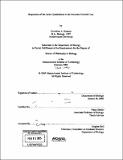| dc.contributor.advisor | Frank Gertler. | en_US |
| dc.contributor.author | Strasser, Geraldine A | en_US |
| dc.contributor.other | Massachusetts Institute of Technology. Dept. of Biology. | en_US |
| dc.date.accessioned | 2008-03-26T20:31:24Z | |
| dc.date.available | 2008-03-26T20:31:24Z | |
| dc.date.copyright | 2005 | en_US |
| dc.date.issued | 2005 | en_US |
| dc.identifier.uri | http://dspace.mit.edu/handle/1721.1/31182 | en_US |
| dc.identifier.uri | http://hdl.handle.net/1721.1/31182 | |
| dc.description | Thesis (Ph. D.)--Massachusetts Institute of Technology, Dept. of Biology, 2005. | en_US |
| dc.description | Includes bibliographical references (leaves 94-111). | en_US |
| dc.description.abstract | During the development of the nervous system, axons and dendrites are guided to their targets throughout the brain and body through the detection of diffusible and surface-bound guidance cues. The growth cone, a specialized structure found at the tips of axons and dendrites, detects and interprets these cues. Activation of downstream intracellular singling pathways leads to changes in the cytoskeleton of the growth cone that affect its motility. Although a number of the key players in this system have been identified, the means by which the growth cone is able to directly rearrange its cytoskeleton in response to guidance cues is not known. In the following experiments, I have examined the roles of several known actin- binding proteins in the remodeling of the growth cone cytoskeleton. The Arp2/3 protein complex binds to an existing actin filament and nucleates formation of a daughter branch. Arp2/3 activity generates a dense actin network in fibroblast cells that drives membrane protrusions. However, the role of this activity in neuronal growth cones has not been established. We have used an inhibitory strategy to explore the requirement for Arp2/3 in growth cone morphology and function. Arp2/3 is not required for growth cone morphology or the generation of protrusive structures; however, it may be required for proper motility in response to axon guidance cues. Activity the EnaNASP family of proteins promotes the formation of long, unbranched filaments in fibroblast systems. Ena/VASP has also been genetically linked to axon guidance pathways in Drosophila, C. elegans, and mice. | en_US |
| dc.description.abstract | (cont.) To examine the role of Ena/VASP proteins in growth cones, we used a strategy to simultaneously inhibit all three mammalian family members in neurons. Ena/VASP proteins were found to have a key role in filopodia formation in growth cones. During the course of my graduate work I was involved in several collaborations that examined the roles of several other proteins involved in the regulation of the actin cytoskeleton. Relevant excerpts from these experiments are presented. | en_US |
| dc.description.statementofresponsibility | by Geraldine A. Strasser. | en_US |
| dc.format.extent | 122 leaves | en_US |
| dc.language.iso | eng | en_US |
| dc.publisher | Massachusetts Institute of Technology | en_US |
| dc.rights | M.I.T. theses are protected by
copyright. They may be viewed from this source for any purpose, but
reproduction or distribution in any format is prohibited without written
permission. See provided URL for inquiries about permission. | en_US |
| dc.rights.uri | http://dspace.mit.edu/handle/1721.1/31182 | en_US |
| dc.rights.uri | http://dspace.mit.edu/handle/1721.1/7582 | en_US |
| dc.subject | Biology. | en_US |
| dc.title | Regulation of the actin cytoskeleton in the neuronal growth cone | en_US |
| dc.type | Thesis | en_US |
| dc.description.degree | Ph.D. | en_US |
| dc.contributor.department | Massachusetts Institute of Technology. Department of Biology | |
| dc.identifier.oclc | 61269877 | en_US |
